Improvement of Sensorial, Physicochemical, Microbiological, Nutritional and Fatty Acid Attributes and Shelf Life Extension of Hot Smoked Half-Dried Pacific Saury (Cololabis saira)
Abstract
:1. Introduction
2. Materials and Methods
2.1. Collection and Preparation of Sample
2.2. Hot Smoking Treatment
2.3. Analysis of Sensorial Characteristics
2.4. Analysis of Physical Properties
2.5. Analysis of Biochemical Properties
2.6. Analysis of TMAO Level
2.7. Analysis of Nutritional Composition
2.8. Analysis of Fatty Acids
2.9. Analysis of Benzo[a]pyrene (BaP)
2.10. Statistical Analysis
3. Results
3.1. Effect of Hot Smoking with Different Sawdust Materials on Odor Intensity and Sensory Characterization
3.2. Optimization of Smoking Treatment
3.3. Hot Smoking Treatment Improved Physical Properties of HDPS
3.3.1. Changes of Weight Loss by the Smoking Time
3.3.2. Changes of Instrumental Texture Analysis by Smoking Time
3.3.3. Changes of Odor Intensity by the Smoking Time
3.3.4. Changes of Color Value by the Smoking Time
3.4. Hot Smoking Treatment Improved Biochemical Features of HDPS
3.4.1. Changes of TBC by the Smoking Time
3.4.2. Changes of pH Value by the Smoking Time
3.4.3. Changes of TBARS Value by the Smoking Time
3.4.4. Changes of VBN Value by the Smoking Time
3.4.5. Changes of Sensorial Characteristics by the Smoking Time
3.5. Hot Smoking Preserved Biochemical Characteristics of HDPS during Storage Condition
3.5.1. Changes of Microbiological Activity
3.5.2. Changes of VBN Level
3.5.3. Changes of Overall Preferences
3.6. Hot Smoking Restricted TMAO Level
3.7. Hot Smoking Preserved Nutritional Quality
3.8. Hot Smoking Preserved Beneficial Fatty Acids
3.9. Hot Smoking Restricted BaP Content
4. Discussions
5. Conclusions
Author Contributions
Funding
Acknowledgments
Conflicts of Interest
References
- Mei, J.; Ma, X.; Xie, J. Review on Natural Preservatives for Extending Fish Shelf Life. Foods 2019, 8, 490. [Google Scholar] [CrossRef] [PubMed] [Green Version]
- Hicks, D.T. Seafood Safety and Quality: The Consumer’s Role. Foods 2016, 5, 71. [Google Scholar] [CrossRef] [PubMed] [Green Version]
- Sallam, K.I.; Ahmed, A.M.; Elgazzar, M.M.; Eldaly, E.A. Chemical quality and sensory attributes of marinated Pacific saury (Cololabis saira) during vacuum-packaged storage at 4 C. Food Chem. 2007, 102, 1061–1070. [Google Scholar] [CrossRef]
- Matsumiya, Y. Dynamics of the saury population in the pacific ocean off northern Japan. I. abundance index in number by size category and fishing ground. Nippon Suisan Gakk. 1976, 42, 277–286. [Google Scholar] [CrossRef] [Green Version]
- Hua, C.; Li, F.; Zhu, Q.; Zhu, G.; Meng, L. Habitat suitability of Pacific saury (Cololabis saira) based on a yield-density model and weighted analysis. Fish. Res. 2020, 221, 105408. [Google Scholar] [CrossRef]
- Jang, M.-S.; Park, H.-Y.; Byun, H.-S.; Park, J.-I.; Kim, Y.-K.; Yoon, N.-Y.; Nam, C.-S. The Nutrient Composition of Commercial Kwamegi Admixed with Functional Ingredients. Korean J. Food Preserv. 2010, 17, 519–525. [Google Scholar]
- Bouriga, N.; Ben Ismail, H.; Gammoudi, M.; Faure, E.; Trabelsi, A. Effect of smoking-method on biochemical and microbiological quality of Nile tilapia (Oreochromis niloticus). Am. J. Food Technol. 2012, 7, 679–689. [Google Scholar]
- Adeyeye, S.A.O. Smoking of fish: A critical review. J. Culin. Sci. Technol. 2019, 17, 559–575. [Google Scholar] [CrossRef]
- Arvanitoyannis, I.S.; Kotsanopoulos, K.V. Smoking of Fish and Seafood: History, Methods and Effects on Physical, Nutritional and Microbiological Properties. Food Bioproc. Technol. 2012, 5, 831–853. [Google Scholar] [CrossRef]
- Bienkiewicz, G.; Tokarczyk, G.; Czerniejewska–Surma, B.; Suryn, J. Changes in the EPA and DHA content and lipids quality parameters of rainbow trout (Oncorhynchus mykiss, Walbaum) and carp (Cyprinus carpio, L.) at individual stages of hot smoking. Heliyon 2019, 5, e02964. [Google Scholar] [CrossRef] [Green Version]
- Fuentes, A.; Fernández-Segovia, I.; Barat, J.M.; Serra, J.A. Physicochemical characterization of some smoked and marinated fish products. J. Food Process. Pres. 2010, 34, 83–103. [Google Scholar] [CrossRef]
- Sutikno, L.A.; Bashir, K.M.I.; Kim, H.; Park, Y.; Won, N.E.; An, J.H.; Jeon, J.-H.; Yoon, S.-J.; Park, S.-M.; Sohn, J.H. Improvement in Physicochemical, Microbial, and Sensory Properties of Common Squid (Todarodes pacificus Steenstrup) by Superheated Steam Roasting in Combination with Smoking Treatment. J. Food Qual. 2019, 2019, 8721725. [Google Scholar] [CrossRef]
- Huang, X.-H.; Qi, L.-B.; Fu, B.-S.; Chen, Z.-H.; Zhang, Y.-Y.; Du, M.; Dong, X.-P.; Zhu, B.-W.; Qin, L. Flavor formation in different production steps during the processing of cold-smoked Spanish mackerel. Food Chem. 2019, 286, 241–249. [Google Scholar] [CrossRef] [PubMed]
- Goulas, A.E.; Kontominas, M.G. Effect of salting and smoking-method on the keeping quality of chub mackerel (Scomber japonicus): Biochemical and sensory attributes. Food Chem. 2005, 93, 511–520. [Google Scholar] [CrossRef]
- Erkan, N. The effect of thyme and garlic oil on the preservation of vacuum-packaged hot smoked rainbow trout (Oncorhynchus mykiss). Food Bioproc. Technol. 2012, 5, 1246–1254. [Google Scholar] [CrossRef]
- Mohibbullah, M.; Won, N.E.; Jeon, J.H.; An, J.H.; Park, Y.; Kim, H.; Bashir, K.M.I.; Park, S.M.; Kim, Y.S.; Yoon, S.J. Effect of superheated steam roasting with hot smoking treatment on improving physicochemical properties of the adductor muscle of pen shell (Atrina pectinate). Food Sci. Nutr. 2018, 6, 1317–1327. [Google Scholar] [CrossRef]
- Baten, M.A.; Won, N.E.; Mohibbullah, M.; Yoon, S.-J.; Hak Sohn, J.; Kim, J.-S.; Choi, J.-S. Effect of hot smoking treatment in improving Sensory and Physicochemical Properties of processed Japanese Spanish Mackerel Scomberomorus niphonius. Food Sci. Nutr. 2020, 8, 3957–3968. [Google Scholar] [CrossRef]
- Bİlgİn, Ș.; Ertan, Ö.; İzci, L. Investigation on changes in the chemical composition of hot smoked Salmo trutta macrostigma, Dumeril 1858, stored different temperatures. J. FisheriesSciences.com 2007, 1, 68–80. [Google Scholar] [CrossRef]
- Stołyhwo, A.; Kołodziejska, I.; Sikorski, Z.E. Long chain polyunsaturated fatty acids in smoked Atlantic mackerel and Baltic sprats. Food Chem. 2006, 94, 589–595. [Google Scholar] [CrossRef]
- Koral, S.; Köse, S.; Tufan, B. The effect of storage temperature on the chemical and sensorial quality of hot smoked Atlantic bonito (Sarda sarda, Bloch, 1838) packed in aluminium foil. Turkish J. Fish. Aquat. Sci. 2010, 10, 439–443. [Google Scholar]
- Tenyang, N.; Tiencheu, B.; Womeni, H.M. Effect of smoking and refrigeration on lipid oxidation of Clupea harengus: A fish commonly consumed in Cameroon. Food Sci. Nutr. 2018, 6, 464–473. [Google Scholar] [CrossRef] [PubMed] [Green Version]
- Lim, J. Hedonic scaling: A review of methods and theory. Food Qual. Prefer. 2011, 22, 733–747. [Google Scholar] [CrossRef]
- Macagnano, A.; Careche, M.; Herrero, A.; Paolesse, R.; Martinelli, E.; Pennazza, G.; Carmona, P.; D’amico, A.; Di Natale, C. A model to predict fish quality from instrumental features. Sensors Actuators B Chem. 2005, 111, 293–298. [Google Scholar] [CrossRef]
- Chen, Y.; Wu, S.; Pan, S. Effect of water-soluble chitosan in combination with glutathione on the quality of pen shell adductor muscles. Int. J. Biol. Macromol. 2015, 72, 1250–1253. [Google Scholar] [CrossRef]
- Ganesan, P.; Benjakul, S. Effect of glucose treatment on texture and colour of pidan white during storage. Int. J. Food Sci. Technol. 2014, 51, 729–735. [Google Scholar] [CrossRef] [Green Version]
- Oğuzhan Yildiz, P. Effect of essential oils and packaging on hot smoked rainbow trout during storage. J. Food Process. Preserv. 2015, 39, 806–815. [Google Scholar] [CrossRef]
- Horwitz, W. Food composition; additives; natural contaminants. In Official Methods of Analysis of AOAC International, 17th ed.; Horwitz, W., Ed.; AOAC International: Rockville, MD, USA, 2000. [Google Scholar]
- Ministry of Food and Drug Safety (MFDS). Food Code, Korean Foods Industry Association; Korean Foods Industry Association Press: Seoul, Korea, 2014. [Google Scholar]
- Weichselbaum, E.; Coe, S.; Buttriss, J.; Stanner, S. Fish in the diet: A review. Nutr. Bull. 2013, 38, 128–177. [Google Scholar] [CrossRef]
- Cho, S.-Y.; Endo, Y.; Fujimoto, K.; Kaneda, T. Oxidative Deterioration of Lipids in Salted and Dried. Nippon Suisan Gakk. 1989, 55, 541–544. [Google Scholar] [CrossRef] [Green Version]
- Secci, G.; Parisi, G. From farm to fork: Lipid oxidation in fish products. A review. Ital. J. Anim. Sci. 2016, 15, 124–136. [Google Scholar] [CrossRef]
- Dillon, R.; Patel, T.R.; Martin, A.M. Microbiological control for fish smoking operations. In Fisheries Processing; Springer: Berlin/Heidelberg, Germany, 1994; pp. 51–81. [Google Scholar]
- Oz, A.T.; Ulukanli, Z.; Bozok, F.; Baktemur, G. The Postharvest Quality, Sensory and Shelf Life of A garicus Bisporus in Active Map. J. Food Process. Preserv. 2015, 39, 100–106. [Google Scholar] [CrossRef]
- Nollet, L.M.L.; Toldrá, F. Handbook of Seafood and Seafood Products Analysis; CRC Press: Boca Raton, FL, USA, 2009. [Google Scholar]
- Zzaman, W.; Bhat, R.; Yang, T.A.; Easa, A.M. Influences of superheated steam roasting on changes in sugar, amino acid and flavour active components of cocoa bean (Theobroma cacao). J. Sci. Food Agric. 2017, 97, 4429–4437. [Google Scholar] [CrossRef] [PubMed]
- Guillén, M.D.; Errecalde, M.C. Volatile components of raw and smoked black bream (Brama raii) and rainbow trout (Oncorhynchus mykiss) studied by means of solid phase microextraction and gas chromatography/mass spectrometry. J. Sci. Food Agric. 2002, 82, 945–952. [Google Scholar] [CrossRef]
- Anastasio, A.; Marrone, R.; Chirollo, C.; Smaldone, G.; Attouchi, M.; Adamo, P.; Sadok, S.; Pepe, T. Swordfish steaks vacuum-packed with Rosmarinus officinalis. Ital. J. Food Sci. 2014, 26, 390–397. [Google Scholar]
- Menon, V. Seafood Processing: Adding Value through Quick Freezing, Retortable Packaging, and Cook-Chilling; CRC Press: Boca Raton, FL, USA, 2005; pp. 1–486. [Google Scholar]
- Monllor, P.; Romero, G.; Atzori, A.S.; Sandoval-Castro, C.A.; Ayala-Burgos, A.J.; Roca, A.; Sendra, E.; Díaz, J.R. Composition, Mineral and Fatty Acid Profiles of Milk from Goats Fed with Different Proportions of Broccoli and Artichoke Plant By-Products. Foods 2020, 9, 700. [Google Scholar] [CrossRef]
- Shahidi, F.; Ambigaipalan, P. Omega-3 Polyunsaturated Fatty Acids and Their Health Benefits. Annu. Rev. Food Sci. Technol. 2018, 9, 345–381. [Google Scholar] [CrossRef]
- Mohibbullah, M.; Choi, J.S.; Bhuiyan, M.M.H.; Haque, M.N.; Rahman, M.K.; Moon, I.S.; Hong, Y.K. The Red Alga Gracilariopsis chorda and Its Active Constituent Arachidonic Acid Promote Spine Dynamics via Dendritic Filopodia and Potentiate Functional Synaptic Plasticity in Hippocampal Neurons. J. Med. Food 2018, 21, 481–488. [Google Scholar] [CrossRef]
- Mohibbullah, M.; Hannan, M.A.; Choi, J.Y.; Bhuiyan, M.M.; Hong, Y.K.; Choi, J.S.; Choi, I.S.; Moon, I.S. The Edible Marine Alga Gracilariopsis chorda Alleviates Hypoxia/Reoxygenation-Induced Oxidative Stress in Cultured Hippocampal Neurons. J. Med. Food 2015, 18, 960–971. [Google Scholar] [CrossRef] [Green Version]
- Hokkanen, M.; Luhtasela, U.; Kostamo, P.; Ritvanen, T.; Peltonen, K.; Jestoi, M. Critical Effects of Smoking Parameters on the Levels of Polycyclic Aromatic Hydrocarbons in Traditionally Smoked Fish and Meat Products in Finland. J. Chem. 2018, 2018, 2160958. [Google Scholar] [CrossRef]
- Stołyhwo, A.; Sikorski, Z.E. Polycyclic aromatic hydrocarbons in smoked fish—A critical review. Food Chem. 2005, 91, 303–311. [Google Scholar] [CrossRef]
- Kannappan, S.; Jasmine, G.I.; Jeyachandran, P.; Selvi, A.T. Polyaromatic hydrocarbons in processed fishery products. J. Food Sci. Technol. 2000, 37, 596–601. [Google Scholar]
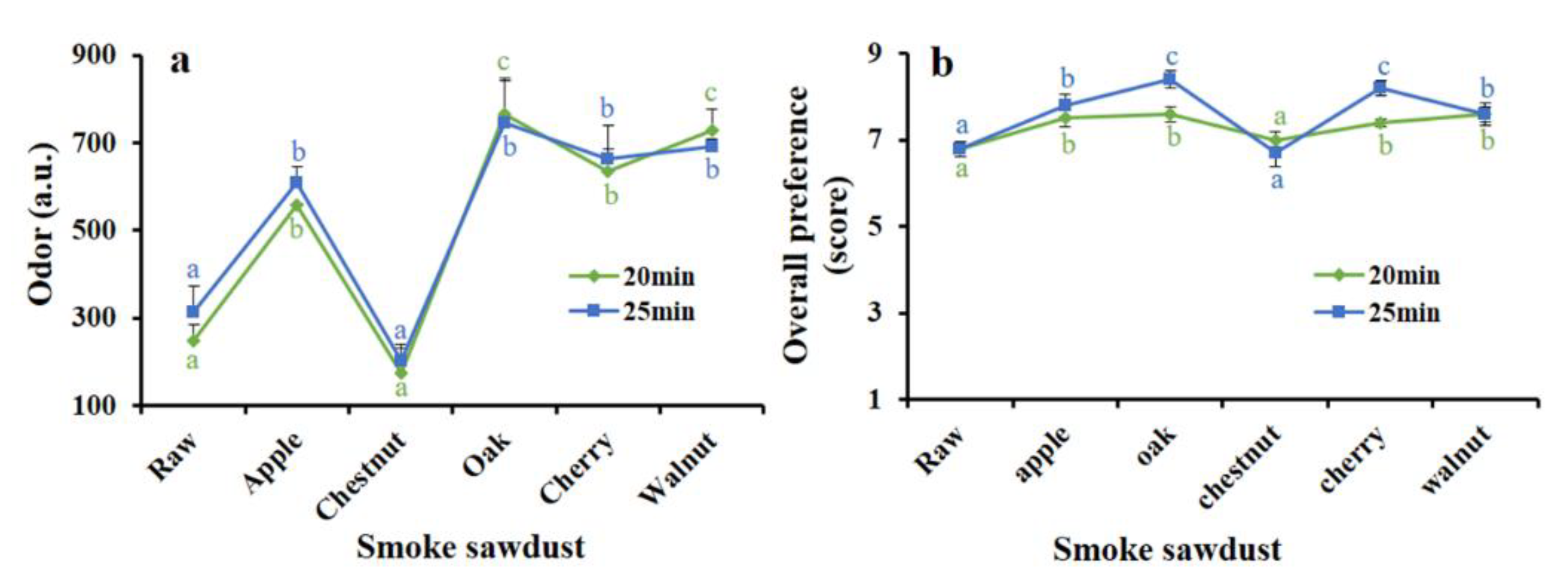
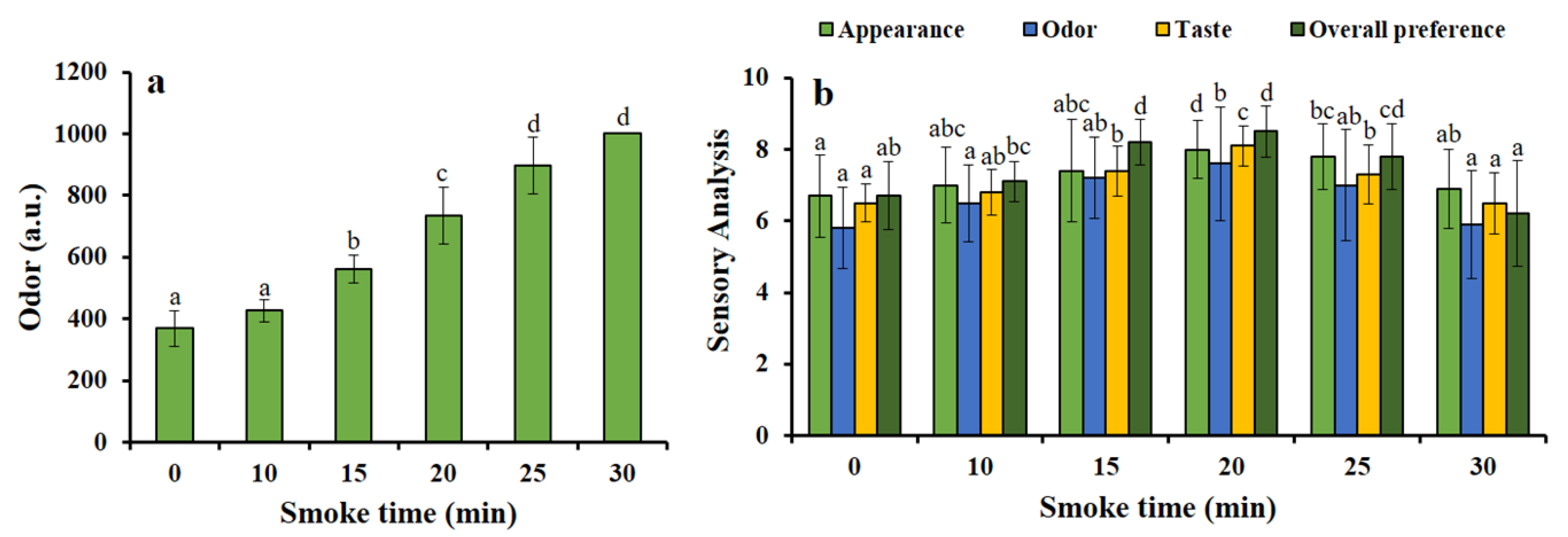
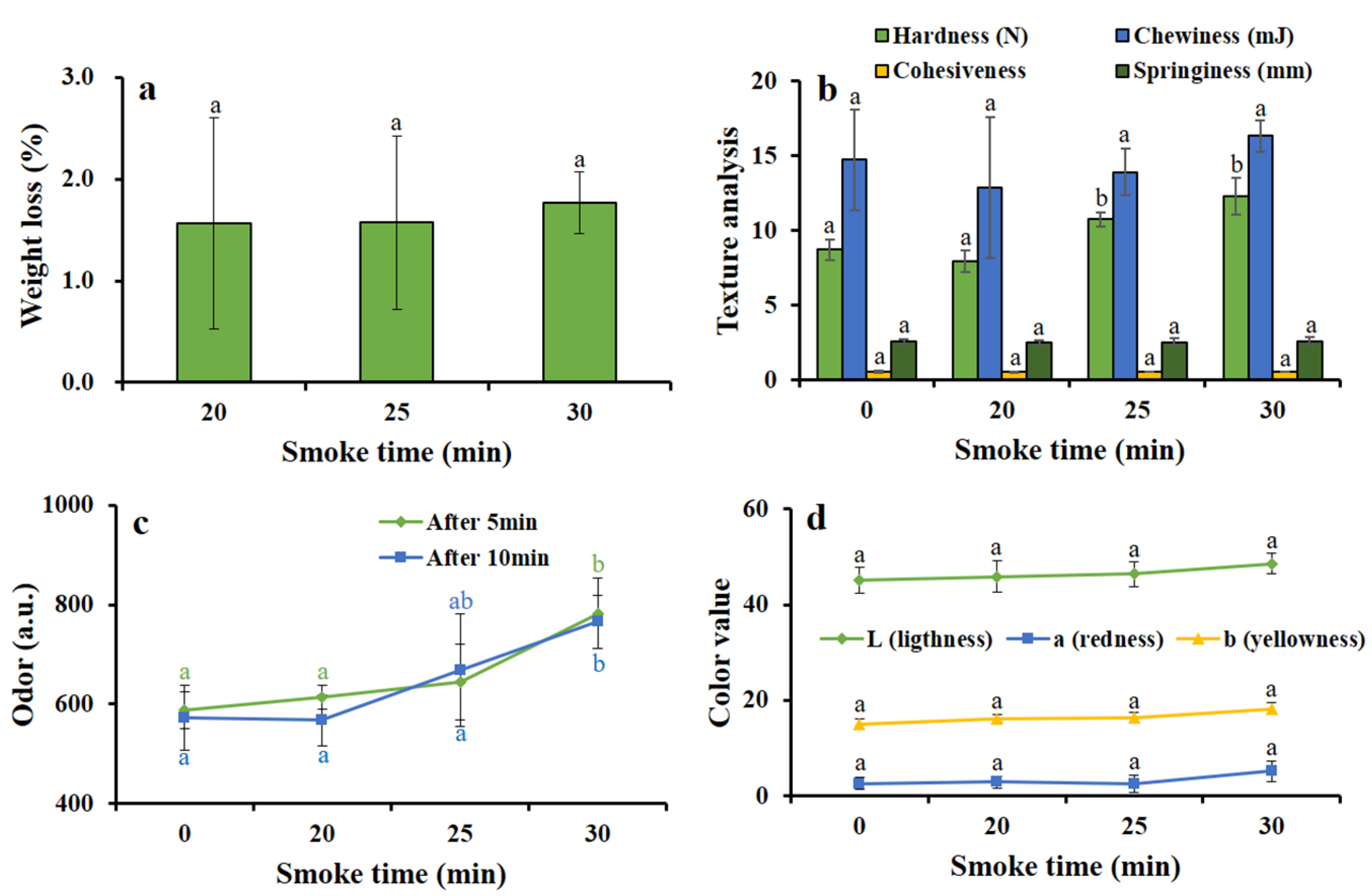
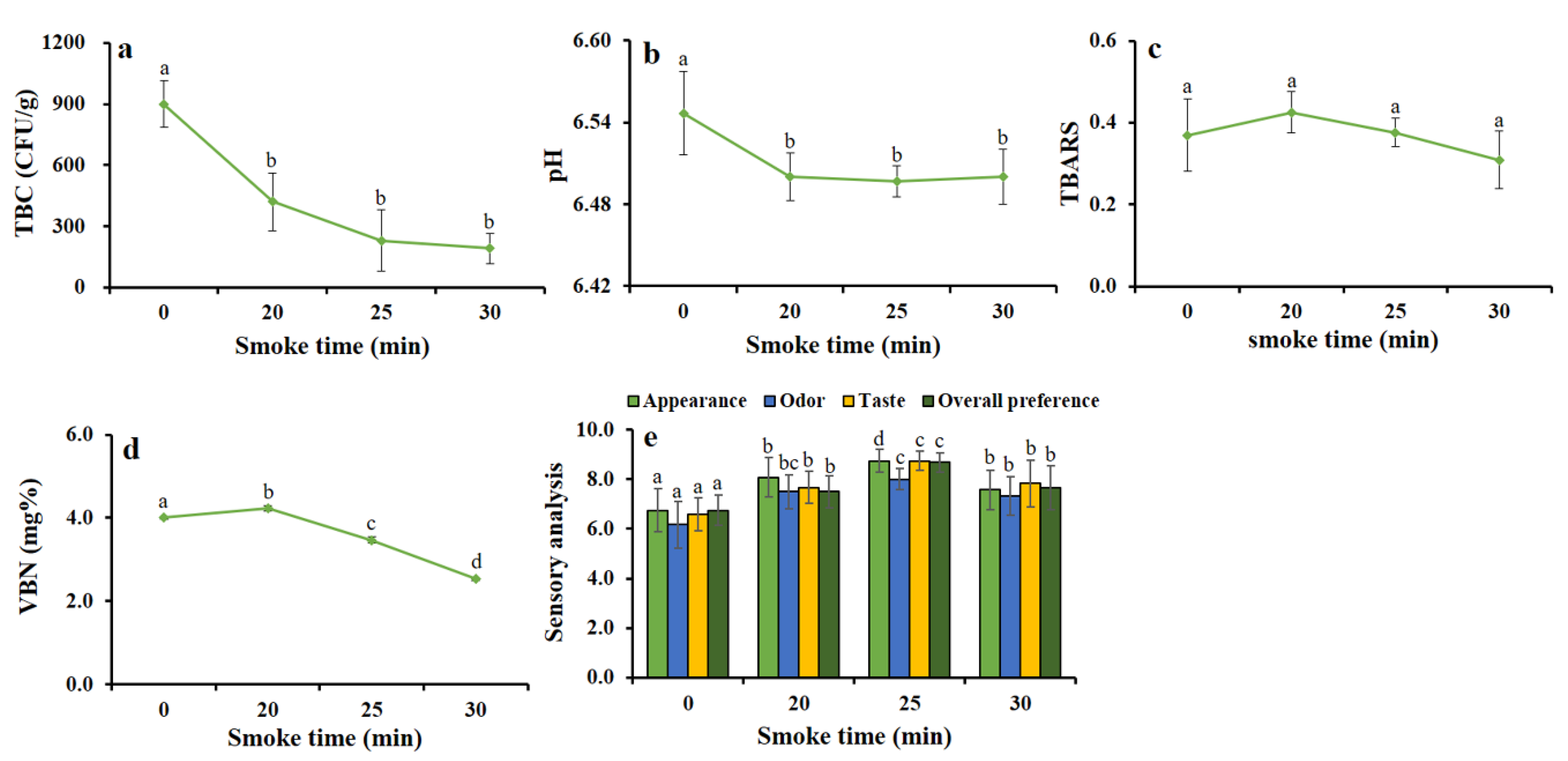

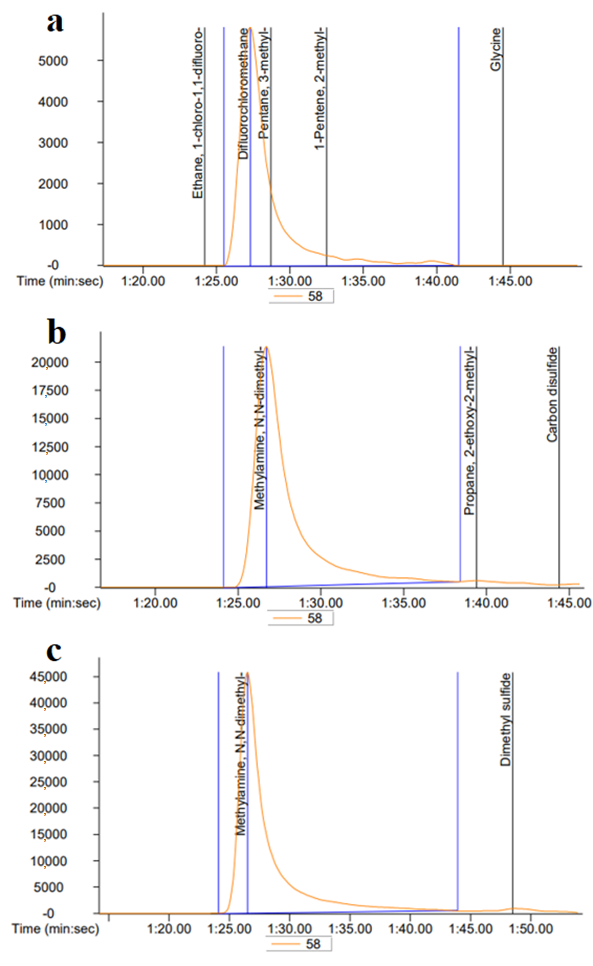
| Storage Duration (Days) | Bacteria (CFU/g) | Coliform | ||
|---|---|---|---|---|
| 10 °C | 15 °C | 10 °C | 15 °C | |
| 0 | 0 | 0 | 0 | 0 |
| 3 | 0 | 0 | 0 | 0 |
| 10 | 0 | 0 | 0 | 0 |
| 14 | 0 | 0 | 0 | 0 |
| 18 | 0 | 21.67 | 0 | 0 |
| 21 | 0 | 36.67 | 0 | 0 |
| 24 | 0 | 45.00 | 0 | 0 |
| 27 | 0 | - | 0 | - |
| 30 | 0 | - | 0 | - |
| 32 | 0 | - | 0 | - |
| Test Items | Unit | Test Results |
|---|---|---|
| Calories | kcal/100 g | 479.885 |
| Sodium | mg/100 g | 208.829 |
| Carbohydrate | g/100 g | 0.316 |
| Sugars | g/100 g | 0.181 |
| Crude fat | g/100 g | 37.749 |
| Trans fat | g/100 g | 0.131 |
| Saturated fat | g/100 g | 9.017 |
| Cholesterol | mg/100 g | 51.588 |
| Crude protein | g/100 g | 34.720 |
| Potassium | mg/100 g | 369.862 |
| Calcium | mg/100 g | 60.013 |
| Iron | mg/100 g | 2.050 |
| Vitamin D | mg/100 g | ND |
| Fatty Acids | Hot Smoked HDPS (g/100 g) | |
|---|---|---|
| Butyric acid | C4: 0 | 0.00 |
| Caproic acid | C6: 0 | 0.00 |
| Caprylic acid | C8: 0 | 0.00 |
| Capric acid | C10: 0 | 0.00 |
| Lauric acid | C12: 0 | 0.01 |
| Tridecanoic acid | C13: 0 | 0.01 |
| Myristic acid | C14: 0 | 1.17 |
| Pentadecanoic acid | C15: 0 | 0.10 |
| Palmitic acid | C16: 0 | 2.35 |
| Stearic acid | C18: 0 | 0.43 |
| Margaric acid | C17: 0 | 0.20 |
| Heneicosanoic acid | C21: 0 | 0.00 |
| Behenic acid | C22: 0 | 0.01 |
| Arachidic acid | C20: 0 | 0.08 |
| Tricosanoic acid | C23: 0 | 0.00 |
| Lignoceric acid | C24: 0 | 0.00 |
| ∑ SFA | 4.36 | |
| Myristoleic acid | C14: 1 | 0.01 |
| Pentadecenoic acid | C15: 1 | 0.00 |
| Palmitoleic acid | C16: 1 | 0.55 |
| Margaroleic acid | C17: 1 | 0.00 |
| Elaidic acid | C18: 1 n-9t | 0.03 |
| Oleic acid | C18: 1 n-9c | 1.04 |
| Cis-11-Eicosenoic acid | C20: 1 n-9 | 1.81 |
| Erucic acid | C22: 1 n-9 | 2.76 |
| Nervonic acid | C24: 1 n-9 | 0.17 |
| ∑ MUFA | 6.37 | |
| Linolelaidic acid | C18: 2 n-6t | 0.19 |
| Linoleic acid | C18: 2 n-6c | 0.32 |
| ϒ-Linolenic acid | C18: 3 n-6 | 0.02 |
| Cis-11, 14-Eicosenoic acid | C20: 2 n-6 | 0.62 |
| Docosadienoic acid | C22: 2 n-6 | 0.13 |
| Cis-11, 14, 17-Eicosenoic acid | C20: 3 n-3 | 0.07 |
| α-Linolenic acid | C18: 3 n-3 | 0.23 |
| Dihomo ϒ-Linolenic acid | C20: 3 n-6 | 0.03 |
| Arachidonic acid | C20: 4 n-6 | 0.08 |
| Eicosapentaenoic acid | C20: 5 n-3 | 1.17 |
| Docosahexaenoic acid | C22: 6 n-3 | 3.03 |
| ∑ PUFA | 5.89 | |
© 2020 by the authors. Licensee MDPI, Basel, Switzerland. This article is an open access article distributed under the terms and conditions of the Creative Commons Attribution (CC BY) license (http://creativecommons.org/licenses/by/4.0/).
Share and Cite
Baten, M.A.; Won, N.E.; Sohn, J.H.; Kim, J.-S.; Mohibbullah, M.; Choi, J.-S. Improvement of Sensorial, Physicochemical, Microbiological, Nutritional and Fatty Acid Attributes and Shelf Life Extension of Hot Smoked Half-Dried Pacific Saury (Cololabis saira). Foods 2020, 9, 1009. https://doi.org/10.3390/foods9081009
Baten MA, Won NE, Sohn JH, Kim J-S, Mohibbullah M, Choi J-S. Improvement of Sensorial, Physicochemical, Microbiological, Nutritional and Fatty Acid Attributes and Shelf Life Extension of Hot Smoked Half-Dried Pacific Saury (Cololabis saira). Foods. 2020; 9(8):1009. https://doi.org/10.3390/foods9081009
Chicago/Turabian StyleBaten, Md. Abdul, Na Eun Won, Jae Hak Sohn, Jin-Soo Kim, Md. Mohibbullah, and Jae-Suk Choi. 2020. "Improvement of Sensorial, Physicochemical, Microbiological, Nutritional and Fatty Acid Attributes and Shelf Life Extension of Hot Smoked Half-Dried Pacific Saury (Cololabis saira)" Foods 9, no. 8: 1009. https://doi.org/10.3390/foods9081009








